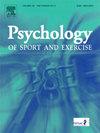How high-performance practitioners think and intervene to change technique
IF 3.3
2区 心理学
Q2 HOSPITALITY, LEISURE, SPORT & TOURISM
引用次数: 0
Abstract
Objective
Changing technique, whereby a permanent strategy is adopted to improve performance or reduce injury risk, is a common goal among sport practitioners in high performance sports. However, there is little information about how technique change is done in practice and whether any evidence-based methods or frameworks are applied. Our aim was to explore individual and team-sport practitioner experiences concerning the process and types of methods adopted for technique change, across a range of practitioner groups and sports.
Design
Qualitative interviews were conducted with fifteen practitioners from three practitioner groups; sport coaches, therapists, and strength & conditioning coaches (S&C), who had experience changing technique with adults in high-performance sports’ settings.
Methods
Data was thematically analyzed guided by a qualitative approach, apriori knowledge on the topic, and a critical realist paradigm.
Results
When intervening, S&Cs and therapists reported focusing on physical assessments and modifications, often divorcing the action from the sport context initially. For example, jump mechanics were assessed on a force plate, followed by jump exercise interventions in isolation, then final applications to the sport and positional demands, such as a header in soccer, were implemented. Coaches reported staying within the sport context, but scaling back task difficulty. There was little evidence that techniques discussed in the literature, such as exaggerating errors, or contrasting between old and new ways, were used to change technique. Practitioners primarily used prescriptive, direct instructional approaches, using feedback to highlight ‘errors’ (focusing attention both internally and externally). They emphasized a practitioner integrated approach for a successful intervention, but there was a lack of objective assessment of an intervention's success, particularly in transfer to competition.
Conclusion
Sport practitioners were regularly working on technique change in a systematic way, but not guided by current evidence-recommended methods. There was a desire to learn more about these methods, particularly those that seemed counter to current direct instructional practice; such as continual contrasting and augmenting of existing ‘errors’. There is a need for greater communication between researchers and practitioners to facilitate awareness of methods and the rationale behind their effectiveness.
高绩效从业者如何思考和干预改变技术。
目的:改变技术,即采用一种永久性的策略来提高成绩或减少受伤风险,是高性能运动中运动从业者的共同目标。然而,关于技术变革如何在实践中实现以及是否应用了任何基于证据的方法或框架的信息很少。我们的目的是探索个人和团队运动实践者在一系列实践者群体和运动中所采用的技术变革过程和方法类型的经验。设计:对来自三个实践者组的15名实践者进行定性访谈;运动教练,治疗师,力量和调节教练(S&C),他们有在高水平运动环境中与成年人改变技术的经验。方法:采用定性方法、主题先验知识和批判现实主义范式对数据进行主题分析。结果:当进行干预时,s&c和治疗师报告关注身体评估和修改,通常最初将动作与运动环境分开。例如,在测力板上评估跳跃力学,然后单独进行跳跃练习干预,最后将其应用于运动和位置要求,例如足球中的头球。教练们报告说,他们停留在运动环境中,但降低了任务难度。几乎没有证据表明,文献中讨论的技术,如夸大错误,或新旧方法之间的对比,被用来改变技术。从业者主要使用规定性的、直接的教学方法,使用反馈来突出“错误”(集中内部和外部的注意力)。他们强调成功的干预需要从业者的综合方法,但缺乏对干预成功的客观评估,特别是在向竞争转移方面。结论:体育从业者有规律地以系统的方式进行技术改变,但没有按照目前证据推荐的方法进行指导。人们渴望更多地了解这些方法,特别是那些似乎与当前直接教学实践相反的方法;比如不断对比和扩大现有的“错误”。研究人员和从业人员之间需要更多的沟通,以促进对方法及其有效性背后的基本原理的认识。
本文章由计算机程序翻译,如有差异,请以英文原文为准。
求助全文
约1分钟内获得全文
求助全文
来源期刊
CiteScore
6.40
自引率
5.90%
发文量
172
审稿时长
69 days
期刊介绍:
Psychology of Sport and Exercise is an international forum for scholarly reports in the psychology of sport and exercise, broadly defined. The journal is open to the use of diverse methodological approaches. Manuscripts that will be considered for publication will present results from high quality empirical research, systematic reviews, meta-analyses, commentaries concerning already published PSE papers or topics of general interest for PSE readers, protocol papers for trials, and reports of professional practice (which will need to demonstrate academic rigour and go beyond mere description). The CONSORT guidelines consort-statement need to be followed for protocol papers for trials; authors should present a flow diagramme and attach with their cover letter the CONSORT checklist. For meta-analysis, the PRISMA prisma-statement guidelines should be followed; authors should present a flow diagramme and attach with their cover letter the PRISMA checklist. For systematic reviews it is recommended that the PRISMA guidelines are followed, although it is not compulsory. Authors interested in submitting replications of published studies need to contact the Editors-in-Chief before they start their replication. We are not interested in manuscripts that aim to test the psychometric properties of an existing scale from English to another language, unless new validation methods are used which address previously unanswered research questions.

 求助内容:
求助内容: 应助结果提醒方式:
应助结果提醒方式:


